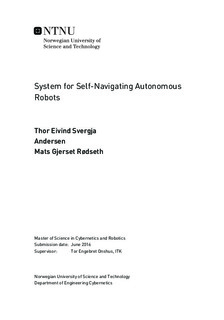System for Self-Navigating Autonomous Robots
Master thesis
Permanent lenke
http://hdl.handle.net/11250/2403559Utgivelsesdato
2016Metadata
Vis full innførselSamlinger
Sammendrag
The purpose of the thesis was to build an Arduino-based robot, whose intended use was to map unknown areas, as well as to develop a server application that controls several robots and uses the gathered information to form a map of the area. Additionally, the wireless communication in the existing solution was to be updated using state-of-the-art technology.
An Arduino-robot was designed and built using materials acquired from Sparkfun, Elfa Distrelec and the Cybernetic Workshops at NTNU. The robot provides the same functionality as existing robots, but due to an encoder that got broken during the final week of the thesis, the position estimates does not work.
The communication protocol was updated from Bluetooth to Bluetooth Smart, using nRF51-dongles developed by Nordic Semiconductor. The software running on the server-dongle was developed in the C programming language.
By studying the existing server application, written in MATLAB, the group got an insight into the system functionality. Most of the same functionality was implemented in a new server application using the Java programming language. The system architecture was designed using modules that took care of one area of responsibility each.
The group developed a Graphical User Interface (GUI) for the system during a design process. Using well-known principles and guidelines during the design phase led to a GUI that has the human perception in mind. The user interface was developed using the intuitive GUI-builder in NetBeans, and the goal was to inherit most of the functionality from the existing solution but provide the information in a more user-friendly way.
